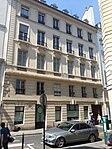Museum of the History of Medicine, Paris

The Museum of the History of Medicine (French: Musée d'histoire de la médecine [myze distwaʁ də la medsin]) is a medical museum in the 6th arrondissement of Paris, France. It is located at 12 rue de l'École de Médecine, on the second floor of the historic École de Chirurgie (nowadays Paris Descartes University). Since 1971 the headquarters of Paris Descartes University have been located in the former premises of the Medical School founded in 1803 and situated in the buildings of the Academy of Surgery. The Museum of the History of Medicine is housed on the second floor of the building, in a room built in 1905. Its collections, the oldest in Europe, were put together by the dean Lafaye in the 18th century, then a considerable collection of pieces covering the different branches of operating art until the end of the 19th century was added. One can also discover several rare medical and surgical bags as well as physiology tools.
Excerpt from the Wikipedia article Museum of the History of Medicine, Paris (License: CC BY-SA 3.0, Authors, Images).Museum of the History of Medicine, Paris
Rue de l'École de Médecine, Paris Quartier de l'Odéon (Paris)
Geographical coordinates (GPS) Address Nearby Places Show on map
Geographical coordinates (GPS)
| Latitude | Longitude |
|---|---|
| N 48.851111111111 ° | E 2.3411111111111 ° |
Address
Faculté de Médecine Paris Centre (Université de Paris)
Rue de l'École de Médecine 15
75006 Paris, Quartier de l'Odéon (Paris)
Ile-de-France, France
Open on Google Maps










